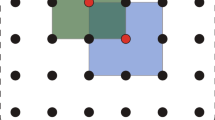Abstract
In most issues representing physical problems, the complex geometry cannot be represented by a Cartesian grid. The multi-block grid technique allows artificially reducing the complexity of the geometry by breaking down the real domain into a number of sub-domains with simpler geometry. The main aim of this article is to show the usefulness of simple solvers in complex geometry problems, when using curvilinear coordinates combined with multi-block grids. This requires adapted solvers to a nine nodes computational cell instead of the five nodes computational cell used with Cartesian coordinates for two-dimensional cases. These developments are presented for the simple iterative methods Jacobi and Gauss-Seidel and also for the incomplete factorization method strongly implicit procedure (SIP). These adapted solvers are tested in two cases: a simple geometry (heat transfer in a circular cross-section) and a complex geometry (solidification case). Results of the simple geometry case show that all the adapted solvers have good performance with a slight advantage for the SIP solver. For increasing the complexity of the geometry, the results showed that Jacobi and Gauss-Seidel solvers are not suitable. However, the SIP method has a reasonable performance. A conclusion could be drawn that the SIP method could be used in complex geometry problems using multi-block grid technique when high precision results are not required.
Similar content being viewed by others
References
D. J. Mavriplis, Unstructured Grid Techniques, Annu. Rev. Fluid Mech. 29(1997) 473–514.
V. Feldheim and P. Lybaert, Solution of radial heat transfer problems with discrete transfer method applied to triangular meshes, Journal of Computational and Applied Mathematics 168 (2004) 179–190.
F. C. Lockwood and N. G. Shah, A new radiation solution method for incorporation in general combustion prediction procedures, 18th International Symposium on Combustion, The Combustion Institute, Pittsburgh, PA (1981) 1405–1414.
B. Wiwatanapataphee, Y. H. Wu, J. Archapitak, P. F. Siew and B. Unyong, A numerical study of the turbulent flow of molten steel in a domain with a phase-change boundary, Journal of Computational and Applied Mathematics. 166 (2004) 307–319.
G. Tryggvason, A. Esmaeeli and N. Al-Rawahi, Direct numerical simulations of flows with phase change, Computers & Structures. 83 (2005) 445–453.
S. Dimova, M. Kaschiev, M. Koleva and D. Vasileva, Numerical analysis of radially nonsymmetric blow-up solutions of a nonlinear parabolic problem, Journal of Computational and Applied Mathematics. 97 (1998) 81–97.
C. W. Lan and F. C. Chen, A finite volume method for solute segregation in directional solidification and comparison with a finite element method, Comput. Methods Appl. Mech. Engrg. 131(1–2) (1996) 191–207.
S. E. Shepel and S. Paolucci, Numerical simulation of filling and solidification of permanent mold casting, Applied Thermal Engineering. 22 (2002), 229–248.
D. A. Knoll, W. B. Vanderheyden, V. A. Mousseau and D. B. Kothe, On preconditioning Newton-Krylov methods in solidifying flow application, SIAM, J. Appl. Math. 23(2) (2001) 381–397.
M. Bellet and V. D. Fachinotti, ALE method for solidification modelling, Comput. Methods. Appl. Mech. Engrg. 193 (2004) 4355–4381.
G. E. Schneider and M. Zedan, A modified Strongly Implicit procedure for the numerical solu tion of field problems, Numer. Heat Transfer. 4(1) (1981) 1–19.
M. Peric, Efficient semi-implicit solving algorithm for nine-diagonal coefficient matrix, Numer. Heat Transfer. 11(3) (1987) 251–279.
J. H. Ferziger and M. Peric, Computational Methods for Fluid Dynamics, 2nd edition, Springer Verlag, Berlin, Heidelberg, New York USA, (1999).
H. Pina, Métodos Numéricos, McGraw-Hill. (1995).
J. C. Tannehill, D. A. Anderson and R. H. Pletcher, Computational Fluid Mechanics and Heat Transfer, 2nd edition, Taylor & Francis Ltd. (1997).
S. E. Norris, A Parallel Navier Stokes Solver for Natural convection and Free Surface Flow. Ph.D Thesis, Faculty of Mechanical Engineering, University of Sydney, Australia, (2001).
H. L. Stone, Iterative solution of implicit approximations of multidimensional partial differential equations, SIAM, J. Numer. Anal. 5 (1968) 530–558.
H. S. Carslaw, J.C. Jaeger, Conduction of Heat in Solids. Clarendon Press, Oxford, (1959).
J. F. Thompson, Z. U. A. Warsi and C. W. Mastin, Numerical Grid Generation, Foundations and Applications, Elsevier Science Publishing Co., Amsterdam, (1985).
A. A. C. Monteiro. Estudos do Comportamento Térmico de Moldações Metálicas para a Fundição Aplicando o Método das Diferenças Finitas Generalizadas, Ph.D. Thesis, University of Minho, Braga, Portugal, (1996).
N. Shamsundar and E. M. Sparrow, Analysis of multidimensional conduction phase change via the enthalpy model, J. Heat Transfer. 97 (1975) 333–340.
E. Monteiro, A. A. C. Monteiro and A. Rouboa. Heat transfer simulation in the mould with generalize curvilinear formulation. Journal of Pressure Vessel Technology. 128 (2006) 462–466.
E. Monteiro and A. Rouboa. Numerical simulation of the aluminium alloys solidification in complex geometries. J. Mech. Sci. Tech. 19(9) (2005) 1773–1780.
A. Rouboa and E. Monteiro, Computational fluid dynamics analysis of greenhouse microclimates by heated underground tubes, J. Mech. Sci. Tech. 21(12) (2007) 2196–2204.
F. Lau, W. B. Lee, S. M. Xiong and B. C. Liu, A study of the interface heat transfer between an iron casting and a metallic mould, J.Mat. Processing Technology. 79 (1998) 25–29.
Author information
Authors and Affiliations
Corresponding author
Additional information
This paper was recommended for publication in revised form by Associate Editor Jun Sang Park
Professor Abel Rouboa obtained his P.h.D. (1994) in Fluid Dynamics at University of Paris VI and CEA, before joining the University of Evry Val d’E-ssonne, Paris, as assistant professor. In September 1999, he joined University of UTAD at Vila real, Portugal as assistant professor then in 2003 as associate professor. His teaching interests include heat transfer, fluid mechanics and numerical analysis. Professor Rouboa’s research interests focus on Computational Fluid Dynamics emphasis on heat transfer. Currently, his research works is, strongly, linking with department of Mechanical Engineering and Applied Mechanics of University of Pennsylvania.
Rights and permissions
About this article
Cite this article
Rouboa, A., Monteiro, E. & de Almeida, R. Finite volume method analysis of heat transfer problem using adapted strongly implicit procedure. J Mech Sci Technol 23, 1553–1562 (2009). https://doi.org/10.1007/s12206-009-0423-3
Received:
Revised:
Accepted:
Published:
Issue Date:
DOI: https://doi.org/10.1007/s12206-009-0423-3




